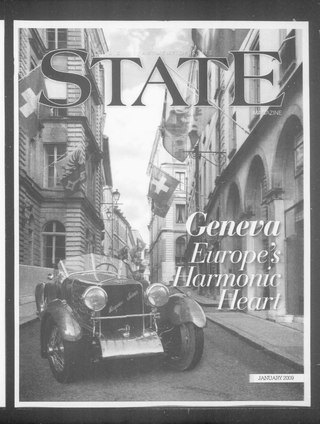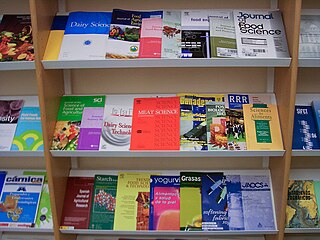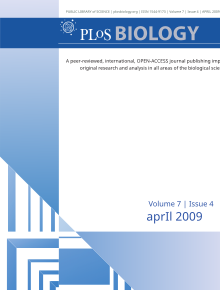
A magazine is a periodical publication, generally published on a regular schedule, containing a variety of content. They are generally financed by advertising, purchase price, prepaid subscriptions, or by a combination of the three.
Computer magazines are about computers and related subjects, such as networking and the Internet. Most computer magazines offer advice, some offer programming tutorials, reviews of the latest technologies, and advertisements.

To publish is to make content available to the general public. While specific use of the term may vary among countries, it is usually applied to text, images, or other audio-visual content, including paper. Publication means the act of publishing, and also any copies issued for public distribution.

This page is a glossary of library and information science.

An academic journal or scholarly journal is a periodical publication in which scholarship relating to a particular academic discipline is published. Academic journals serve as permanent and transparent forums for the presentation, scrutiny, and discussion of research. They nearly universally require peer review or other scrutiny from contemporaries competent and established in their respective fields. Content typically takes the form of articles presenting original research, review articles, or book reviews. The purpose of an academic journal, according to Henry Oldenburg, is to give researchers a venue to "impart their knowledge to one another, and contribute what they can to the Grand design of improving natural knowledge, and perfecting all Philosophical Arts, and Sciences."
The bibliographical definition of an edition is all copies of a book printed from substantially the same setting of type, including all minor typographical variants.
A monograph is a specialist written work or exhibition on one subject or one aspect of a usually scholarly subject, often by a single author or artist. Although a monograph can be created by two or more individuals, its text remains a coherent whole and it keeps being an in-depth academic work that presents original research, analysis, and arguments. As a focused, in-depth and specialised written work in which one or more authors develop a uniform and continuous argument or analysis over the course of the book, a monograph is essentially different from an edited collection of articles. In an edited collection, a number of original and separate scholarly contributions by different authors are edited and compiled into one book by one or more academic editors.
The Society for the Diffusion of Useful Knowledge (SDUK) was founded in London in 1826, mainly at the instigation of Whig MP Henry Brougham, with the object of publishing information to people who were unable to obtain formal teaching or who preferred self-education. It was a largely Whig organisation, and published inexpensive texts intended to adapt scientific and similarly high-minded material for the rapidly-expanding reading public over twenty years until it was disbanded in 1846.

Tankōbon is the Japanese term for a book that is not part of an anthology or corpus. The term is also used in reference to individual volumes of a manga series: most series first appear as individual chapters in a weekly or monthly manga anthology with other works before being published as tankōbon volumes containing several chapters each.

Penny dreadfuls were cheap popular serial literature produced during the 19th century in the United Kingdom. The pejorative term is roughly interchangeable with penny horrible, penny awful, and penny blood. The term typically referred to a story published in weekly parts of 8 to 16 pages, each costing one penny. The subject matter of these stories was typically sensational, focusing on the exploits of detectives, criminals, or supernatural entities. First published in the 1830s, penny dreadfuls featured characters such as Sweeney Todd, Dick Turpin, Varney the Vampire, and Spring-heeled Jack.
Annual publications, more often simply called annuals, are periodical publications appearing regularly once per year. Although exact definitions may vary, types of annuals include: calendars and almanacs, directories, yearbooks, annual reports, proceedings and transactions and literary annuals. A weekly or monthly publication may produce an Annual featuring similar materials to the regular publication. Some encyclopedias have published annual supplements that essentially summarize the news of the past year, similar to some newspaper yearbooks.

A partwork is a written publication released as a series of planned magazine-like issues over a period of time. Issues are typically released on a weekly, fortnightly or monthly basis, and often a completed set is designed to form a reference work on a particular topic.
In publishing and library and information science, the term serial is applied to materials "in any medium issued under the same title in a succession of discrete parts, usually numbered and appearing at regular or irregular intervals with no predetermined conclusion."
CODEN – according to ASTM standard E250 – is a six-character, alphanumeric bibliographic code that provides concise, unique and unambiguous identification of the titles of periodicals and non-serial publications from all subject areas.

Monographic series are scholarly and scientific books released in successive volumes, each of which is structured like a separate book or scholarly monograph.

In literature, a serial is a printing or publishing format by which a single larger work, often a work of narrative fiction, is published in smaller, sequential instalments. The instalments are also known as numbers, parts, fascicules or fascicles, and may be released either as separate publications or within sequential issues of a periodical publication, such as a magazine or newspaper.

Electrician and Mechanic was an American science and technology magazine published from 1890 to January 1914 when it merged with Modern Electrics to become Modern Electrics & Mechanics. In July 1914, incorporated with Popular Electricity and the World's Advance and the title became Popular Electricity and Modern Mechanics. The new publisher, Modern Publishing, began a series of magazine mergers and title changes so numerous that librarians began to complain. In October 1915 the title became Popular Science Monthly and the magazine is still published under that name today.

A volume is a physical book. It may be printed or handwritten. The term is commonly used to identify a single book that is part of a larger collection. Volumes are typically identified sequentially with Roman or Arabic numerals, e.g. "volume III" or "volume 3", commonly abbreviated to "Vol.".
Perceptions was an LGBT news magazine which began publication in 1983 in Saskatoon, Saskatchewan, Canada.












